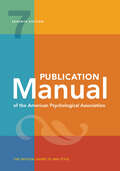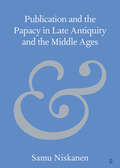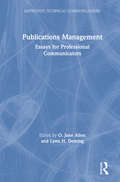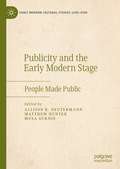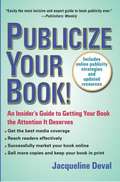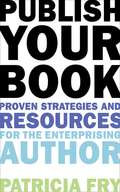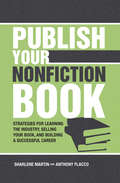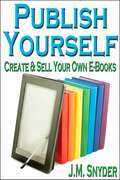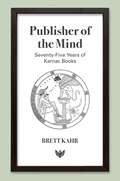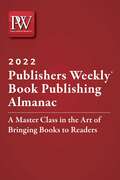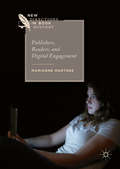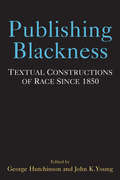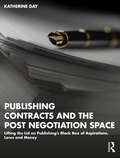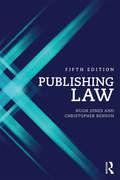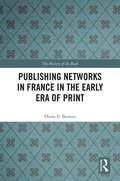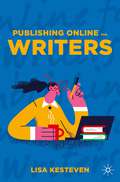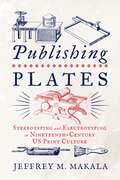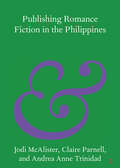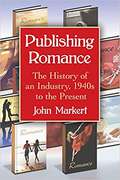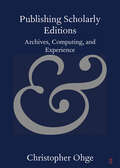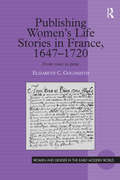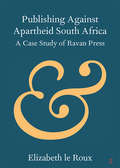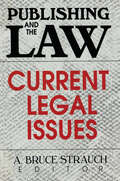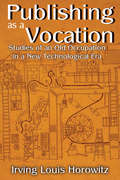- Table View
- List View
Publication Manual (OFFICIAL) 7th Edition of the American Psychological Association
by American Psychological AssociationA WALL STREET JOURNAL, USA TODAY, AND PUBLISHERS WEEKLY BESTSELLER. The newest official release of the Publication Manual of the American Psychological Association, Seventh Edition includes four different formats—spiral-bound and tabbed, paperback, hardcover, and ebook, all of which are in full color. It is the official source for APA Style. With millions of copies sold worldwide in multiple languages, the Publication Manual of the American Psychological Association, Seventh Edition is the style manual of choice for writers, researchers, editors, students, and educators in the social and behavioral sciences, natural sciences, nursing, communications, education, business, engineering, and other fields. Known for its authoritative, easy-to-use reference and citation system, the Publication Manual also offers guidance on choosing the headings, tables, figures, language, and tone that will result in powerful, concise, and elegant scholarly communication. It guides users through the scholarly writing process—from the ethics of authorship to reporting research through publication. The seventh edition is an indispensable resource for students and professionals to achieve excellence in writing and make an impact with their work. The seventh edition has been thoroughly revised and updated to reflect best practices in scholarly writing and publishing. All formats are in full color, with a new tabbed spiral version Improved ease of navigation, with many additional numbered sections to help users quickly locate answers to their questions Resources for students on writing and formatting annotated bibliographies, response papers, and other paper types as well as guidelines on citing course materials Dedicated chapter for new users of APA Style covering paper elements and format, including sample papers for both professional authors and student writers New chapter on journal article reporting standards (JARS) that includes updates to reporting standards for quantitative research and the first-ever qualitative and mixed methods reporting standards in APA Style Updated chapter on bias-free language guidelines for writing about people with respect and inclusivity in areas including age, disability, gender, participation in research, racial and ethnic identity, sexual orientation, socioeconomic status, and intersectionality More than 40 new sample tables and figures Expanded guidance on ethical writing and publishing practices, including how to ensure the appropriate level of citation, avoid plagiarism and self-plagiarism, and navigate the publication process More than 100 new reference examples covering periodicals, books, audiovisual media, social media, webpages and websites, legal resources, and more Guidelines that support accessibility for all users, including simplified reference, in-text citation, and heading formats as well as additional font options
Publication Manual (OFFICIAL) 7th Edition of the American Psychological Association
by American Psychological AssociationA WALL STREET JOURNAL, USA TODAY, AND PUBLISHERS WEEKLY BESTSELLER. The newest official release of the Publication Manual of the American Psychological Association, Seventh Edition includes four different formats—spiral-bound and tabbed, paperback, hardcover, and ebook, all of which are in full color. It is the official source for APA Style. With millions of copies sold worldwide in multiple languages, the Publication Manual of the American Psychological Association, Seventh Edition is the style manual of choice for writers, researchers, editors, students, and educators in the social and behavioral sciences, natural sciences, nursing, communications, education, business, engineering, and other fields. Known for its authoritative, easy-to-use reference and citation system, the Publication Manual also offers guidance on choosing the headings, tables, figures, language, and tone that will result in powerful, concise, and elegant scholarly communication. It guides users through the scholarly writing process—from the ethics of authorship to reporting research through publication. The seventh edition is an indispensable resource for students and professionals to achieve excellence in writing and make an impact with their work. The seventh edition has been thoroughly revised and updated to reflect best practices in scholarly writing and publishing. All formats are in full color, with a new tabbed spiral version Improved ease of navigation, with many additional numbered sections to help users quickly locate answers to their questions Resources for students on writing and formatting annotated bibliographies, response papers, and other paper types as well as guidelines on citing course materials Dedicated chapter for new users of APA Style covering paper elements and format, including sample papers for both professional authors and student writers New chapter on journal article reporting standards (JARS) that includes updates to reporting standards for quantitative research and the first-ever qualitative and mixed methods reporting standards in APA Style Updated chapter on bias-free language guidelines for writing about people with respect and inclusivity in areas including age, disability, gender, participation in research, racial and ethnic identity, sexual orientation, socioeconomic status, and intersectionality More than 40 new sample tables and figures Expanded guidance on ethical writing and publishing practices, including how to ensure the appropriate level of citation, avoid plagiarism and self-plagiarism, and navigate the publication process More than 100 new reference examples covering periodicals, books, audiovisual media, social media, webpages and websites, legal resources, and more Guidelines that support accessibility for all users, including simplified reference, in-text citation, and heading formats as well as additional font options
Publication and the Papacy in Late Antiquity and the Middle Ages (Elements in Publishing and Book Culture)
by Samu NiskanenThis Element explores the papacy's engagement in authorial publishing in late antiquity and the Middle Ages. The opening discussion demonstrates that throughout the medieval period, papal involvement in the publication of new works was a phenomenon, which surged in the eleventh century. The efforts by four authors to use their papal connexions in the interests of publicity are examined as case studies. The first two are St Jerome and Arator, late antique writers who became highly influential partly due to their declaration that their literary projects enjoyed papal sanction. Appreciation of their publication strategies sets the scene for a comparison with two eleventh-century authors, Fulcoius of Beauvais and St Anselm. This Element argues that papal involvement in publication constituted a powerful promotional technique. It is a hermeneutic that brings insights into both the aspirations and concerns of medieval authors. This title is also available as Open Access on Cambridge Core.
Publications Management: Essays for Professional Communicators (Baywood's Technical Communications)
by O. Jane Allen Lynn H Deming"Publications Management: Essays for Professional Communicators" is a collection of essays designed for use in academic programs in technical and professional communication and for communication professionals in the workplace. The contributors include publications managers in the workplace and academics who teach in technical and professional communication programs. Their multiple perspectives offer a broad introduction to some of the important issues publications.
Publicity and the Early Modern Stage: People Made Public (Early Modern Cultural Studies 1500–1700)
by Matthew Hunter Allison K. Deutermann Musa GurnisWhat did publicity look like before the eighteenth century? What were its uses and effects, and around whom was it organized? The essays in this collection ask these questions of early modern London. Together, they argue that commercial theater was a vital engine in celebrity’s production. The men and women associated with playing—not just actors and authors, but playgoers, characters, and the extraordinary local figures adjunct to playhouse productions—introduced new ways of thinking about the function and meaning of fame in the period; about the networks of communication through which it spread; and about theatrical publics. Drawing on the insights of Habermasean public sphere theory and on the interdisciplinary field of celebrity studies, Publicity and the Early Modern Stage introduces a new and comprehensive look at early modern theories and experiences of publicity.
Publicize Your Book (Updated)
by Jacqueline DevalFor first-time authors or the seasoned pro, this is the absolutely essential how-to for getting publicity?totally updated and expanded. This indispensable guide from a book publicity insider offers everything authors must know to assist their publishers in publicizing, marketing, and promoting their books, including: ? Effective networking ? Defining a target readership ? Creating pitches for talk shows ? Getting media coverage ? Utilizing the Internet and other outlets ? Preparing for interviews and tours ? Hiring an independent publicist With totally revised and updated information, advice, and resources, the insiders all agree: ?Read this book!?( Ellen Levine, editorial director, Hearst Magazines)
Publish Your Book: Proven Strategies and Resources for the Enterprising Author
by Patricia FryPublish Your Book: Proven Strategies and Resources for the Enterprising Author is a professional guide to publishing success for the new and struggling author. With insider tips, up-to-date marketing strategies, timelines, and other resources, this book offers a comprehensive tour of the world of book publishing to help authors successfully navigate the industry.Whether you write fiction or nonfiction, this book will help you write your book for a target audience, build promotion into your book, write a successful query letter and book proposal, choose the right publishing option for your book, establish or strengthen your platform, get your book into bookstores, and successfully promote and sell your book. Authors and publishers in any genre and at any stage of the publishing process will benefit from this comprehensive resource, which is an exceptional companion to Promote Your Book (Allworth Press, 2011).
Publish Your Nonfiction Book
by Anthony Flacco Sharlene MartinPublishing Your Nonfiction BookIn Publish Your Nonfiction Book, successful literary agent Sharlene Martin and noted novelist and nonfiction author Anthony Flacco draw on their years of experience to provide you with an in-depth understanding of what the publishing industry is really like and how to successfully navigate it in order to ensure a long-term career.You'll learn:Techniques for writing a strong query letter that hooks agents and editors right from the startStrategies for putting together a stellar proposal package that successfully pitches you and your bookMethods for creating a respectable author platform - before you start pitching your bookTips for getting an agent and building a lasting working relationshipAnd much, much more!Plus, the authors examine actual query letters and proposals that worked, so you can see firsthand exactly what catches an agent's attention and why.Publish Your Nonfiction Book is the one-on-one agent consultation you need - but seldom get - to learn the ropes and seal the deal.
Publish Yourself: Create & Sell Your Own E-Books
by J. M. SnyderIf you've ever wanted to retain more of your royalties or try publishing e-books but didn't know where to start, this book is for you!Recently e-books have exploded onto the publishing scene, making it easier than ever for writers to break into the market. But many people who read e-books aren't familiar with how to create them. What formats should you offer? Where do you sell them? What do you use for a cover? And, most important, how do you go from a Word document to an EPUB, MOBI, or PDF file?Best-selling, multi-published author J.M. Snyder has written this no-nonsense, hands-on guide. She takes the mystery out of e-publishing while making the process of creating an e-book simple, cheap, and easy.Using Microsoft Word (or an equivalent word processing program) along with inexpensive or free software readily available online, you will learn how to create the nine most common e-book formats. You will be walked through cover art design, interior book layout, and e-book creation, as well as given many of the tips J.M. has learned along the way. Also included is a brief guide to online bookstores where you can sell your finished e-book.Let J.M. Snyder help you discover how easy it is to publish yourself!
Publisher of the Mind: Seventy-Five Years of Karnac Books
by Brett KahrKarnac Books was founded on 24 March 1950 by Harry Karnac as a general interest bookshop at Gloucester Road, London SW7. Following strong sales of a D. W. Winnicott title, Harry Karnac began to increase his stock of mental health titles until they came to occupy the full floor of the shop's basement. Word spread through the global mental health community and Karnac Books became the epicentre for English mental health publications, not only as a must-visit venue but also as a thriving mail-order business. Before long, Harry took the plunge into publishing alongside bookselling and the Karnac imprint was born. Since 1950, Karnac has changed hands several times and Brett Kahr has met, befriended, and interviewed every single owner from the eponymous Harry Karnac to the present day. His detailed knowledge as customer, author, and friend of Karnac makes him the perfect person to write this history, undertaken as a labour of love and published to celebrate Karnac's 75th anniversary. The book begins with an amusing introduction on the welcome affliction of Karnacitis, swiftly followed by a comprehensive history of early psychoanalytic publishing before leading into the first instalment of the chronicles of Karnac. The behind-the-scenes story of the iconic Karnac Books shows why it rose to be a pivotal member of the mental health community and continues to this day.
Publishers Weekly Book Publishing Almanac 2022: A Master Class in the Art of Bringing Books to Readers
by Publishers WeeklyAnnouncing the first edition of Publishers Weekly Book Publishing Almanac 2022. Designed to help authors, editors, agents, publicists, and anyone else working in book publishing understand the changing landscape of book publishing, it is an essential reference for anyone who works in the industry. Written by industry veterans and co-published with Publishers Weekly magazine, here is the first-ever book to offer a comprehensive view of how modern book publishing works. It offers history and context, as well as up-to-the-minute information for anyone interested in working in the field and for authors looking to succeed with a publisher or by self-publishing. You&’ll find here information on: Finding an agentSelf-publishingAmazonBarnes & Noble and other book chainsIndependent bookstores Special sales (non-traditional book markets)DistributionForeign marketsPublicity, Marketing, AdvertisingSubsidiary rightsBook productionE-books and audiobooksDiversity, equity, and inclusion across the industryAnd more! Whether you&’re a seasoned publishing professional, just starting out in the business, or simply interested in how book publishing works, the Publishers Weekly Book Publishing Almanac will be an annual go-to reference guide and an essential, authoritative resource that will make that knowledge accessible to a broad audience. Featuring original essays from and interviews with some of the industry's most insightful and innovative voices along with highlights of PW's news coverage over the last year, the Publishers Weekly Book Publishing Almanac is an indispensable guide for publishers, editors, agents, publicists, authors and anyone who wants better to understand this business, its history, and its mysteries.
Publishers, Readers, and Digital Engagement
by Marianne MartensThis book demonstrates how the roles of "author," "marketer," and "reviewer" are being redefined, as online environments enable new means for young adults to participate in the books they love. Prior to the expansion of digital technologies around reading, teachers, parents and librarians were the primary gatekeepers responsible for getting books into the hands of young people. Now publishers can create disintermediated digital enclosures in which they can communicate directly with their reading audience. This book exposes how teens contribute their immaterial and affective labor as they engage in participatory reading experiences via publishers' and authors' interactive websites and use of social media, and how in turn publishers are able to use such labor as they get invaluable market research, peer-to-peer recommendations, and even content which can be used in other projects -- all virtually free-of-charge.
Publishing Blackness: Textual Constructions of Race Since 1850
by George Hutchinson John YoungFrom the white editorial authentication of slave narratives, to the cultural hybridity of the Harlem Renaissance, to the overtly independent publications of the Black Arts Movement, to the commercial power of Oprah's Book Club, African American textuality has been uniquely shaped by the contests for cultural power inherent in literary production and distribution. Always haunted by the commodification of blackness, African American literary production interfaces with the processes of publication and distribution in particularly charged ways. An energetic exploration of the struggles and complexities of African American print culture, this collection ranges across the history of African American literature, and the authors have much to contribute on such issues as editorial and archival preservation, canonization, and the "packaging" and repackaging of black-authored texts. Publishing Blackness aims to project African Americanist scholarship into the discourse of textual scholarship, provoking further work in a vital area of literary study.
Publishing Contracts and the Post Negotiation Space: Lifting the Lid on Publishing’s Black Box of Aspirations, Laws and Money
by Katherine DayMany writers dream of having their work published by a respected publishing house, but don’t always understand publishing contract terms – what they mean for the contracting parties and how they inform book-publishing practice. In turn, publishers struggle to satisfy authors’ creative expectations against the industry’s commercial demands. This book challenges our perceptions of these author–publisher power imbalances by recasting the publishing contract as a cultural artefact capable of adapting to the industry’s changing landscape. Based on a three-year study of publishing negotiations, Katherine Day reveals how relational contract theory provides possibilities for future negotiations in what she describes as a ‘post negotiation space’. Drawing on the disciplines of cultural studies, law, publishing studies and cultural sociology, this book reveals a unique perspective from publishing professionals and authors within the post negotiation space, presenting the editor as a fundamental agent in the formation and application of publishing’s contractual terms.
Publishing Law
by Christopher Benson Hugh JonesPublishing Law is an authoritative and engaging guide to a wide range of legal issues affecting publishing today. Hugh Jones and Christopher Benson present readers with clear and accessible guidance to the complex legal areas specific to the ever evolving world of contemporary publishing, including copyright, moral rights, contracts and licensing, privacy, confidentiality, defamation, infringement and trademarks, with analysis of legal issues relating to sales, advertising, marketing, distribution and competition. This new fifth edition presents updated coverage of the key principles of copyright , as well as new copyright exceptions, licensing and open access. There is also further in-depth coverage of the legal issues around the sale of digital content. Key features of the fifth edition include: updated coverage of EU and UK copyright, including a new chapter on copyright exceptions following the significant changes in the 2014 Regulations Comprehensive coverage of publishing contracts with authors, as well as with other providers, including translators, contributors and contracts for subsidiary rights up to date coverage of the Defamation Act 2013, and other changes to EU and UK legislation exploration of the legal issues relating to digital publishing, including eBook and other electronic agreements, data protection and online issues in relation to privacy, and copyright infringement a range of summary checklists on key issues, ranging from copyright ownership to promotion and data protection useful appendices offering an A to Z glossary of legal terms and lists of useful address and further reading.
Publishing Networks in France in the Early Era of Print (The History of the Book)
by Diane E. BootonThis book examines commercial and personal connections in the early modern book trade in Paris and northwestern France, ca. 1450–1550. The book market, commercial trade, and geo-political ties connected the towns of Paris, Caen, Angers, Rennes, and Nantes, making this a fertile area for the transference of different fields of knowledge via book culture. Diane Booton investigates various aspects of book production (typography and illustration), market (publishers and booksellers), and ownership (buyers and annotators) and describes commercial and intellectual dissemination via established pathways, drawing on primary and archival sources.
Publishing Online for Writers
by Lisa KestevenPublishing online can be a daunting prospect for any writer. This book equips aspiring writers with a range of practical skills and tactics for entering the online publishing world. It will guide readers on where and how to publish online, whether writing for magazines, journals, blogs, or podcasts. The textbook includes practical exercises for developing skills such as producing an e-book, creating an e-book marketing strategy, and building an online writer’s presence.It also features step-by-step guides, examples and checklists that help readers research and find appropriate sites to submit work to, and show how to take a completed manuscript through to publication. This textbook will appeal to students, freelance writers, creative writers, poets, novelists and anyone interested in publishing content online to promote and sell their work more effectively.
Publishing Plates: Stereotyping and Electrotyping in Nineteenth-Century US Print Culture (Penn State Series in the History of the Book)
by Jeffrey M. MakalaFirst realized commercially in the late eighteenth century, stereotyping—the creation of solid printing plates cast from moveable type—fundamentally changed the way in which books were printed. Publishing Plates chronicles the technological and cultural shifts that resulted from the introduction of this technology in the United States.The commissioning of plates altered shop practices, distribution methods, and even the author-publisher relationship. Drawing on archival records, Jeffrey M. Makala traces the first uses of stereotyping in Philadelphia in 1812, its adoption by printers in New York and Philadelphia, and its effects on the trade. He looks closely at the printers, typefounders, authors, and publishers who watched small, regional, artisan-based printing traditions rapidly evolve, clearing the way for the industrialized publishing industry that would emerge in the United States at midcentury. Through case studies of the publisher Mathew Carey and the American Bible Society, one of the first publishers of cheap Bibles, Makala explores the origins of the American publishing industry and American mass media. In addition, Makala examines changes in the notion of authorship, copyright, and language and their effects on writers and literary circles, giving examples from the works and lives of Herman Melville, Sojourner Truth, Edgar Allan Poe, Henry David Thoreau, and Walt Whitman, among others. Incorporating perspectives from the fields of book history, the history of technology, material culture studies, and American studies, this book presents a rich, detailed history of an innovation that transformed American culture.
Publishing Romance Fiction in the Philippines (Elements in Publishing and Book Culture)
by Jodi McAlister Claire Parnell Andrea Anne TrinidadThe romance publishing landscape in the Philippines is vast and complex, characterised by entangled industrial players, diverse kinds of texts, and siloed audiences. This Element maps the large, multilayered, and highly productive sector of the Filipino publishing industry. It explores the distinct genre histories of romance fiction in this territory and the social, political and technological contexts that have shaped its development. It also examines the close connections between romance publishing and other media sectors alongside unique reception practices. It takes as a central case study the Filipino romance self-publishing collective #RomanceClass, analysing how they navigate this complex local landscape as well as the broader international marketplace. The majority of scholarship on romance fiction exclusively focuses on the Anglo-American industry. By focusing here on the Philippines, the authors hope to disrupt this phenomenon, and to contribute to a more decentred, rhizomatic approach to understanding this genre world.
Publishing Romance: The History of an Industry, 1940s to the Present
by John MarkertRomance novels have attracted considerable attention since their mass market debut in 1939, yet seldom has the industry itself been analyzed. Founded in 1949, Harlequin quickly gained market domination with their contemporary romances. Other publishers countered with historical romances, leading to the rise of "bodice-ripper" romances in the 1970s. The liberation of the romance novel's content during the 1980s brought a vitality to the market that was dubbed a revolution, but the real romance revolution began in the 1990s with developments in the mainstream publishing industry and continues today. This book traces the history and evolution of the romance industry, covering successful (and not so successful) trends and describing changes in romance publishing that paved the way for the many popular subgenres flooding the market in the 21st century.
Publishing Scholarly Editions: Archives, Computing, and Experience (Elements in Publishing and Book Culture)
by Christopher OhgePublishing Scholarly Editions offers new intellectual tools for publishing digital editions that bring readers closer to the experimental practices of literature, editing, and reading. Sections 1 and 2 frame intentionality and data analysis as intersubjective, interrelated, and illustrative of experience-as-experimentation. In them, I explore these ideas in two editorial projects of nineteenth-century works: Herman Melville's Billy Budd, Sailor and the anti-slavery anthology The Bow in the Cloud, edited by Mary Anne Rawson. Section 3 uses philosophical Pragmatism to rethink editorial principles and data modelling, arguing for a broader conception of the edition rooted in data collections and experience. The Conclusion draws attention to the challenges of publishing digital editions, and why they have failed to be supported by the publishing industry. If publications are conceived as pragmatic 'inventions' based on reliable, open-access data collections, then editing will embrace the critical, aesthetic, and experimental affordances of editions of experience.
Publishing Women's Life Stories in France, 1647-1720: From Voice to Print (Women and Gender in the Early Modern World)
by Elizabeth C. GoldsmithIn this new study, Elizabeth Goldsmith continues her pursuit of issues treated in her earlier books on conversation, epistolary writing, and the female voice in literature. She examines how French women in the seventeenth and early eighteenth centuries first came to publish their private life stories; in doing so, she explores what the writers have to say about why they decide to write about themselves, what they choose to write, how they get their stories circulated and printed, and what they do to defend themselves against the threat to personal reputation and credibility that was implied by such public self-exposure. Goldsmith scrutinizes the autobiographical writing of six women, all of whom were, for different reasons, the objects of fairly intense publicity during their lifetime, at the historical moment when the idea of "publicity" via the printed word was still a new concept. Three of the women-Jeanne des Anges, Marie de l'Incarnation, and Jeanne Guyon-were charismatic religious figures whose writings were widely circulated. The other three writers-the sisters Hortense and Marie Mancini, and Madame de Villedieu-are more worldly, but like their spiritual counterparts, they undertook self-publication as a form of conversation with the world, and a way of participating in other forms of public discourse. Publishing Women's Life Stories in France, 1647-1720 considers the different forms that the life writing of these three women took: autobiographies; letter correspondences (which in four of the six cases have never before been published); trial transcripts; testimonials published as part of other authors' works; and written self-portraits that were circulated among friends. Drawing on the work of Michel de Certeau on voice and communities of readers in the 17th century, as well as the work of Roger Chartier and other historians of the book and print culture, Goldsmith retraces the complicated networks of human interaction that underlie these early a
Publishing against Apartheid South Africa: A Case Study of Ravan Press (Elements in Publishing and Book Culture)
by Elizabeth le RouxIn many parts of the world, oppositional publishing has emerged in contexts of state oppression. In South Africa, censorship laws were enacted in the 1960s, and the next decade saw increased pressure on freedom of speech and publishing. With growing restrictions on information, activist publishing emerged. These highly politicised publishers had a social responsibility, to contribute to social change. In spite of their cultural, political and social importance, no academic study of their history has yet been undertaken. This Element aims to fill that gap by examining the history of the most vocal and arguably the most radical of this group, Ravan Press. Using archival material, interviews and the books themselves, this Element examines what the history of Ravan reveals about the role of oppositional print culture.
Publishing and the Law: Current Legal Issues
by Linda S KatzGet the latest information on new developments in copyright law!This timely volume sheds light on the important legal issues that influence the scholarly publishing world. The often-confusing field of publishing law--including copyright, licensing, liability, electronic publishing, and taxation--is going through an unprecedented upheaval as we move into the twenty-first century. Publishing and the Law: Current Legal Issues offers clear, current explanations of the implications of recent laws and technologies and predicts what further changes to expect. Featuring legal, business, and publishing experts, Publishing and the Law discusses the wide-ranging implications of the decline of fair use, the rise of software licensing, the Communications Decency Act, and such landmark legal cases as LaMacchia, Feist, and Matthew Bender. Questions of ownership, fair use, and licensing--historically a problem for authors such as Twain and Dickens--have become exacerbated by the fact that information is no longer static, but rather fluid and transportable. Publishing and the Law addresses the vital questions of interest to librarians, publishers, and scholars, including: How will changing technologies affect the legal status of libraries, universities, authors, and publishers? What are the latest trends in liability for authors and publishers? How does anti-trust law affect library budgets? Why is copyright giving way to licensing, and what does that mean for libraries? How has the definition of fair use changed? Do attempts to censor the Internet abrogate First Amendment rights? How does electronic publishing force changes to the rules that worked for traditional printed books and journals?In an age of advancing technology, Congress and the courts will be called upon with more and more frequency to maintain a balance between the copyright holder's economic interests and society's right to have access to information. Librarians, university administrators, authors, and publishers can benefit from Publishing and the Law: Current Legal Issues to help them understand current trends in intellectual property law.
Publishing as a Vocation: Studies of an Old Occupation in a New Technological Era
by Irving HorowitzThe linkage of politics and technology is now the driving momentum in communication. Publishers are now part of the astonishing transformation of the slow to the instant. From twitters to bloggers, the communication of ideas can now be accomplished in a matter of minutes, not weeks, months, or even years.Horowitz believes that at its best, information technology can be harnessed to facilitate the expression of democratic thought. In providing better access to production and technology, there is great hope to liberate humankind from ignorance and ideology—and imagination is what the purpose of publishing is and always will be about. If politics is the art of the possible, then technology can be harnessed to the higher art of transforming scientific principles into everyday practices.Publishing as a Vocation places publishing in America in its political and commercial setting. It addresses the political implications of scholarly communication in the era of new computerized technology. Horowitz examines problems of political theory in the context of property rights versus the presumed right to know, and the special strains involved in publishing as commerce versus information as a public trust. Offering a knowledgeable and insightful view of publishing in America and abroad, this book makes an important contribution to the study of mass culture in advanced societies.
